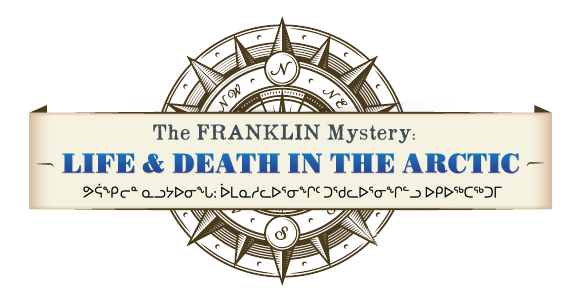Interview with Tom Zagon

Tom Zagon is an Environment Canada scientist who prepared a detailed study on the ice and climatological factors bearing upon the search for Franklin.
Lyle Dick – Interview Tom Zagon, related to his observations concerning the missing last expedition of Sir John Franklin
1) When and how did you first hear of the missing expedition of Sir John Franklin?
I’m not sure when exactly, but I remember in 1993 during my first trip to the Arctic, I was reading Pierre Berton’s well-known book The Arctic Grail with details of the Arctic expeditions, and that really brought out the details of the different expeditions for me. I remember standing on the ice in Barrow Strait in May of 1993 and looking south and thinking to myself: “They went that way; I wonder what happened to them?” And that was twenty years ago and it’s very interesting to be involved in the work from the ice and climatology side.
2) What happened to Franklin's party?
In terms of looking at the conditions where we know the ships were beset and abandoned. I’ve seen on the images in September of some years is that you have a transition from conditions that show low ice concentrations to conditions of high ice concentrations. Because in mid-September, the weather turns bad: storms come through the region. And what we see is that a condition that would be easily navigable for sailing vessels turns very quickly into one of the besetment, especially just north of King William Island. So I think what happened in September 1846 is that they were making progress, but they were basically hit by a storm that caused both vessels to be beset on September 12.
3) Why did they fail?
So, first thing the storm; secondly where the storm hit, where they became beset north of Cape Felix; and the third thing is that we know that these ships are not icebreakers. So the ice conditions that allowed them to enter that area must have been very light. However, those ice conditions are the exception rather than the rule. So what possibly occurred is that they had light conditions in 1845-1846 that allowed these vessels to enter this area, but conditions returned to normal or went below normal, that basically things didn’t break up to the same extent in 1847-1848. Therefore the ships didn’t make any progress and were eventually abandoned.
4) Where are the ships?
So one of those vessels is most likely along the Adelaide Peninsula. In my opinion it’s just at the northern tip of the Klutschak Peninsula, which is directly east of the northern tip of O’Reilly. Why do I say that? That’s because, once again, imagery has shown that there’s pressure along the coast of the peninsula and the type of pressure that would push a ship toward the shore line, or ashore, or for it to be grounded in one of the features just off the coast. So I suspect that one of the vessels could be just north of Alexandra Strait and the other vessel is directly eastward of the north end of O’Reilly, at the tip of the Klutschak.
5) How do you know?
Well, there are three pieces of evidence that I think are really, really important. One is Hall’s statement about the ship being east of O’Reilly, between its north end and Wilmot and Crampton Bay. If the common interpretation of that point put them on the northeast of the north end of the O’Reilly. However, when you look at satellite imagery and pressure, there’s really no reason for a ship to sink there because the waters are deep, and you don’t see pressure in that area. You do see pressure directly eastward of the north end, at the tip of the Klutschak Peninsula, and the waters are much shallower there which would mean of course grounding is much more, well, basically, likely.
[...]
The second piece of evidence I think is that famous map by Innookpoozhejook in 1869 that has been fairly difficult to interpret. And the astounding thing that you see on satellite imagery is that, well maybe the map by Innookpoozhejook doesn’t only include a coastline or land and water, but actually includes ice features. And one of the interesting things about the location of that vessel which isn’t located on that map, is that apparently it contradicts the evidence of it being north east of the O’Reilly. But what you see on the imagery, is that O’Reilly is not drawn as an island, it’s drawn as a peninsula. It’s a peninsula of ice. It’s a peninsula of fast ice.
[...]
And the third point is Schwatka’s evidence about the ship being seen beset west of Grant Point. Once again, satellite imagery shows that there doesn’t have to be contradiction between Hall and Schwatka. It’s not, who’s right, is it one or the other? In fact, when you look at the drift, the drift of the ice is past the position indicated by Schwatka, towards O’Reilly. It just probably means that the ship, after it cleared Alexandra Strait, spent another winter west of Grand Point but probably didn’t sink there. After [the] breakup, it continued its journey.
6) Why do you care?
Well, I’ve worked in shipping, in Arctic shipping all my life, so I approach it in a bit of the way of an accident investigation, I’ve looked a lot at incidents where ships become beset, where ships come into trouble, and I think you have to approach it a bit from that practical manner. It is something that really becomes an obsession in a way, because it’s one of those- it’s a Canadian mystery, it’s a world mystery, it’s one of those great things that you know is solvable, with effort you can find these ships. And it’s exciting because you’re bringing together information from so many different sources.
7) What is the significance of Franklin's last expedition?
Obviously it was an effort to get through the Northwest Passage and led to a lot of exploration afterwards. Much of the Canadian Arctic was explored after that expedition. It’s interesting that no ships actually went through, went down Peel Sound to search for him because they probably couldn’t, because ice conditions were too difficult. But to me right now it signifies how important luck can be in making or breaking an expedition and I think even the best prepared expeditions and knowledge and planning is always susceptible to a certain amount of luck or bad luck or providence. And I think this is an example of an extreme case of bad luck.


